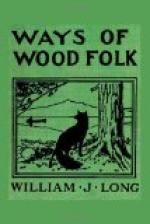On stormy days the birds, instead of resting on the shoals, light near some lonely part of the beach and, after watching carefully for an hour or two, to be sure that no danger is near, swim ashore and collect in great bunches in some sheltered spot under a bank. It is indeed a tempting sight to see perhaps a hundred of the splendid birds gathered close together on the shore, the greater part with heads tucked under their wings, fast asleep; but if you are to surprise them, you must turn snake and crawl, and learn patience. Scattered along the beach on either side are single birds or small bunches evidently acting as sentinels. The crows and gulls are flying continually along the tide line after food; and invariably as they pass over one of these bunches of ducks they rise in the air to look around over all the bank. You must be well hidden to escape those bright eyes. The ducks understand crow and gull talk perfectly, and trust largely to these friendly sentinels. The gulls scream and the crows caw all day long, and not a duck takes his head from under his wing; but the instant either crow or gull utters his danger note every duck is in the air and headed straight off shore.
The constant watchfulness of black ducks is perhaps the most remarkable thing about them. When feeding at night in some lonely marsh, or hidden away by day deep in the heart of the swamps, they never for a moment seem to lay aside their alertness, nor trust to their hiding places alone for protection. Even when lying fast asleep among the grasses with heads tucked under their wings, there is a nervous vigilance in their very attitudes which suggests a sense of danger. Generally one has to content himself with studying them through a glass; but once I had a very good opportunity of watching them close at hand, of outwitting them, as it were, at their own game of hide-and-seek. It was in a grassy little pond, shut in by high hills, on the open moors of Nantucket. The pond was in the middle of a plain, perhaps a hundred yards from the nearest hill. No tree or rock or bush offered any concealment to an enemy; the ducks could sleep there as sure of detecting the approach of danger as if on the open ocean.
One autumn day I passed the place and, looking cautiously over the top of a hill, saw a single black duck swim out of the water-grass at the edge of the pond. The fresh breeze in my face induced me to try to creep down close to the edge of the pond, to see if it were possible to surprise birds there, should I find any on my next hunting trip. Just below me, at the foot of the hill, was a swampy run leading toward the pond, with grass nearly a foot high growing along its edge. I must reach that if possible.




